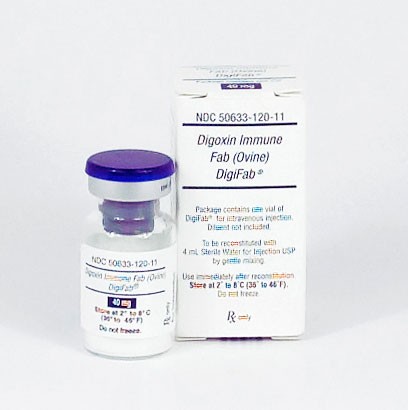

Hypersensitivity ReactionsĪnaphylaxis and hypersensitivity reactions are possible. Postpone re-digitalization, if possible, until the Fab fragments have been eliminated this may require several days or a week or longer in patients with impaired renal function.

Monitor frequently and provide additional inotropic support if needed. Patients with poor cardiac function may deteriorate secondary to the withdrawal of the inotropic action of digoxin by DIGIFab. Rapid drop in serum potassium concentration may occur after treatment. Consider toxic effects of other drugs or poisons in cases where signs and symptoms of digitalis toxicity are not relieved by administration of DIGIFab. Suicidal ingestion may result from more than one drug. IMPORTANT SAFETY INFORMATION Warnings and Precautions General Manifestations of life-threatening toxicity of digoxin overdose such as severe ventricular arrhythmias, progressive bradycardia, and second or third degree heart block not responsive to atropine, serum potassium levels exceeding 5.5 mEq/L in adults or 6 mEq/L in children with rapidly progressive signs and symptoms of digoxin toxicity.Chronic ingestions causing steady-state serum digoxin concentrations >6 ng/mL in adults or 4 ng/mL in children.Known suicidal or accidental consumption of fatal doses of digoxin: 10 mg or more of digoxin in healthy adults, or 4 mg (or more than 0.1 mg/kg) in healthy children, or ingestion of an amount that can cause steady state serum concentrations of ≥10 ng/mL.The clinical response to titrated doses was safe and acceptable in acute digoxin poisoning.Īcute digoxin intoxication Digoxin-Fab overdose.DIGIFab is indicated for the treatment of patients with life-threatening or potentially life-threatening digoxin toxicity or overdose, including: The new practice of using small, titrated doses of Digoxin-Fab led to a considerable reduction in total usage and major savings. There were no deaths from acute digoxin toxicity. Ten patients had a rebound of digoxin >2.6 nmol/L (2 µg/L).
Digifab dose free#
Free digoxin concentrations dropped to almost zero after any dose of Digoxin-Fab. Twelve had free digoxin concentrations measured. Total dose used in the titration group was 25% and 35% of the predicted doses based on the amount of digoxin ingested or measured serum concentration, respectively. The median potassium concentration decrease post-Digoxin-Fab was 0.3 mmol/L. Median maximal change in HR post-Digoxin-Fab was 19 beats/min. Twenty-one patients received repeated titrated doses (1-2 vials) of Digoxin-Fab and the median total dose was 4 vials (IQR: 2-7.5). Four patients received an initial bolus dose of Digoxin-Fab of 5-20 vials. Gastrointestinal symptoms and acute kidney injury were present in 22 patients (88%) and 5 patients (20%), respectively. Initial median digoxin and potassium concentrations were 14.5 nmol/L (IQR: 10.9-20) and 5 mmol/L (IQR: 4.5-5.4 mmol/L), respectively. Median heart rate (HR) was 41 beats/min before treatment. Median dose ingested was 13 mg(IQR: 9.5-25).

Outcomes were recorded and analysed.įrom September 2013 to September 2020, 23 patients with 25 presentations (median age 56 years, females 56%) were recruited. Patient demographics, signs and symptoms of digoxin toxicity, doses and response to Digoxin-Fab, free and bound serum digoxin concentrations. This is a prospective observational study of patients with acute digoxin poisoning identified through two Poisons Information Centres and three toxicology units. However, a recent revision of internal Poisons Information Centre guidelines prompted a change of our recommendations, specifically instead of large boluses, to use titrating repeated low doses of digoxin antibodies(Digoxin-Fab) based on bedside assessment of cardiac toxicity. For acute digoxin poisoning, it has been recommended to give bolus doses of 10-20 vials or potentially larger than needed doses calculated from dose ingested or the measured concentration.


 0 kommentar(er)
0 kommentar(er)
